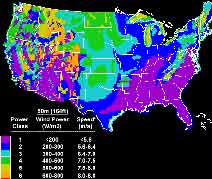
Orange areas have strongest wind
The Mid West and the Great Basin are the best places in America for wind power, according to this map from the US Dept of Energy. More detailed maps can be found here.
Wind is among the lower-priced renewable energy technologies available today. It can cost as little as 4-6 cents per kilowatt-hour, depending on the specifics. The map categorizes America into wind power classes of 1 to 7. Only class 4 and above are able to use the wind turbines on the market today.
Wind energy systems involve a significant initial investment.
� Small wind systems can work on the grid as well, making you off-grid ready. A grid-tied wind turbine can reduce your use of public utility-supplied electricity. On the flip side when your wind turbine produces more energy then your need, it can be sold to your utility (depending on state/local regulations). With the interconnections available today the switch can happen automatically.
Stand alone wind systems are designed for homes, farms and/or communities that are located away from utility lines and located in practical conditions. Conditions to look for are:
� Living in an area with average annual wind speeds of at least 4.0 meters per second (9 miles per hour)
� Grid connections are not available or expensive. Running a power line to a remote site from the utility grid can be prohibitive, it can range from $15,000 to more than $50,000 per mile, depending on your terrain.
� A decided interest in gaining energy independence from the utility
� A desire to reduce the environmental impact of electricity production
� Understanding the intermittent nature of wind power and have a plan for using other resources to meet your power needs during down times.
Conditions for a grid connected system are:
� Living in an area with average annual wind speeds of at least 4.5 meters per second (10 miles per hour).
� Grid supplied electricity is expensive in your area (about 10 to 15 cents per kilowatt-hour).
� Local/State requirements for connecting your system to the grid are not too expensive.
� You can legally erect a wind turbine on your property, check local building codes.
Six per cent of the contiguous U.S. land area has the potential to supply nearly double the current demand for electricity in the entire United States.
